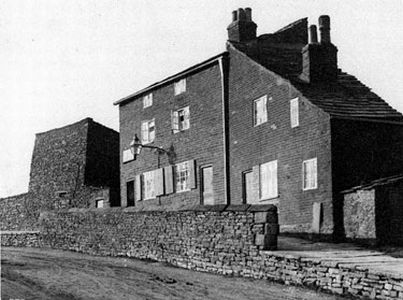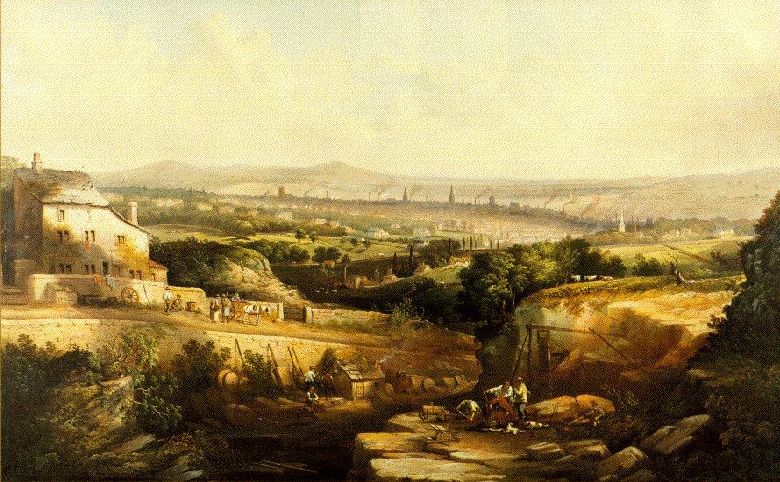
Once called Salters Way, Psalter Lane formed the turnpike road from Sheffield into Derbyshire via Ringinglow. This road was an ancient pack- horse salt road from the Cheshire salt mines, 'Salters' were dealers in salt or meat salted to preserve it. There are several other roads in England with the same name.
Following the Turnpike Act of 1760 funds could be raised from tolls allowing
the upkeep of the highway. In many cases this meant not just providing a firm
level gravel surface, but sinking huge boulders into the soft peaty soil.

The Turnpike highway started on Sheffield Moor, up London Road and Sharrow Lane to Psalter Lane. Cemetery Rd was then merely a bridle path until the General Cemetery opened in 1836. The toll-house was situated at the bottom of the hill at Banner Cross and was demolished in the 1900s.
From Banner Cross the toll-road climbs steeply up Ringinglow Road to Bents
Green where the "Hammer and Pincers" provided refreshment, water, and farriers
to repair horse or oxen metal shoes. The next toll-house being the Round House,
Ringinglow opposite "The Norfolk Arms".

Here the road turns west over Houndkirk Moor to "The Fox House" where huge Millstone Grit stone sets centred 4 ft. 8½ inches apart (the width of a Roman chariot, known colloquially as the Roman road), prevented cart-wheels from sinking into the soft black moorland peat. Remains of these stone sets can still be seen at Ringinglow and Stanage Edge.


An inn and smithy had been located at the top of what is now Sharrow Lane, to cater for the drovers, horses, and oxen after toiling up the hill out of Sheffield, since early times. Here the animals could be watered and re-shod. The inn stood in the grounds of the house of the Rev. Alecxander MacKenzie, vicar of St Paul's, Pinstone St. who demolished the old inn and had the inn was rebuilt and re-named "The Stag's Head" (a stag features in the MacKenzie coat-of-arms).
When the road was formally adopted and given a name, it was altered slightly from the original Salter's Way with its connotations of 'trade' and 'commerce', to Psalter Lane in order to attract wealthy residents -- a stroke of ecclesiastic genius adding the silent P to salter, changing the word without changing the sound and meaning of the original -- a psalter being a book of plms. Among those eminent residents was Samuel Wilson of Wilson’s Snuff Mill who was born here at Nº 2 Psalter Lane.


Psalter Lane Quarries 1875 by Joseph Wrightson MacIntyre - A View of Sheffield from Psalter Lane.
These cottages were erected to house workers in Brincliffe Quarry, the name derived from domestic lidded salt boxes, normally hung on a wall near a fireplace to keep the salt dry.
With the advent of the motor car the smithy became a garage selling petrol. In 1911, Brincliffe Quarry having been filled, the old Sheffield Boys’ Blue Coat School in East Parade behind Sheffield Cathedral in the town centre transferred to a new building on Psalter Lane formally opened by the Countess Fitzwilliam. The accommodation housed 100 orphaned boys who were educated, maintained and clothed.
In 1939 during WWII, the school building was requisitioned by the British Army providing a searchlight and machine-gun emplacement protecting the city from enemy aircraft. Following the destruction of the original College of Art in Arundel Street blitzed during the war, Sheffield College of Arts & Crafts in 1945 moved into the old Blue Coat School building.
The Rev. Alexander MacKenzie, by virtue of his name, played no small part in my family's background. My great-grandfather, John Wilson, met his wife Mary Padley while out walking along MacKenzie's Walk. She was a miliner's assistant living with a professional man and his wife at Sharrow Head at the top of the lane. When John and Mary married in 1865, they rented accommodation at 161 MacKemzie’s Walk where Grandfather Harry was born.
My Grandmother Rebecca died in a nursing home on Psalter Lane and when I started primary school my school-chum, Robert Miles, lived on Mackenzie Street, as MacKenie's Walk had now become. In September 1953 I attended Brinclffe College, cycling along Psalter Lane most days.